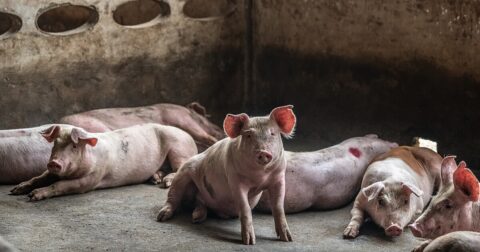Explainer
Reproductive Exploitation of Male Livestock Is an Overlooked Cornerstone of Factory Farming
Food•6 min read
Reported
The rise of intensive animal agriculture in the EU has created a new phenomenon: the landless farm. Exempt from key welfare protections, these farms pose a serious threat to farmed animals.


Words by Sophie Kevany
The rise of intensive animal agriculture has created what would once have been an impossibility, the oxymoronic landless farm.
The term is nearly unknown, possibly for good reason. Putting photos of large dark sheds crammed with animals on bacon packets might not encourage sales. Nor does the term appear in any official documentation, possibly for similar reasons.
The presence of disease, overcrowding, frustration, boredom, cages, and mutilations are the welfare issues most often associated with landless farms, along with the absence of grass, mud, sunlight, room to move, and fresh air. But in the European Union, there is another absence: fines for animal mistreatment.
The closest landless farms come to being officially recognized appears to be a 2018 European Parliament report which notes that in many EU countries intensive pig farms “mostly do not have agricultural land.”
Nor, despite their existence, does any official term describe the EU’s landless farms, said Alice DiConcetto. DiConcetto is a lawyer, founder of the Animal Law Europe consultancy and legal consultant to the Coller Animal Law Forum (CALF), a newly launched, publicly accessible animal policy database aimed at improving food systems and farmed animal law.
“Unlike in U.S. law, EU law does not provide a definition for industrial farm animal production units,” said DiConcetto. The U.S. term Concentrated Animal Feeding Operation (CAFO), is not used either, although the terms CAFO and landless farm fit the EU’s intensive pig production system “to a T,” she said.
The absence of an official definition, she added, offers a possible advantage: less transparency. “[N]o definition means no data, means no clear vision provided to citizens on what the dominant production model has become in Europe,” she said.
One of the defining features of landless farms, DiConcetto said, is that animal feed is not grown “on any portion of the lot or facility where the animals are confined.” Instead, landless farms must purchase feed, much of which is grown in Brazil, where deforestation to clear land for soy and other feed crops is common, or in Europe using environmentally-unfriendly monocropping systems.
Another, often overlooked feature, is that farm animal owners are less likely to be punished for breaking welfare rules. This is because the EU’s core sanctions system for animal welfare breaches relies on a farm having land, for which it receives subsidies. Once known as cross-compliance, now as conditionality, the punishment system works by reducing subsidies for farmers who break animal welfare rules. Landless farms however do not receive subsidies and are therefore in no danger of losing them if they fail to comply with animal welfare rules.
The lack of sanctions for mistreatment on landless farms appears to be part of the reason routine pig tail removal is rampant in Ireland, and elsewhere in the EU, despite being illegal. In its observations, the 2018 European Parliament report links routine tail-docking—considered by one Irish study to affect 99 percent of Irish pigs—to the absence of a sanctions system.
Cutting a pig’s tail off is meant to solve the problem of tail biting by other pigs. But the causes of tail biting – which can include discomfort, lack of bedding, poor air quality, and boredom – are often ignored.
Nor is routine tail-docking the only welfare problem facing Ireland’s almost 1.7 million pigs, most of whom are kept indoors according to a 2015 report.
The report found it “unlikely that outdoor pig production will become significant in Ireland in the foreseeable future.” More recently, Ireland’s 2020 pig census found that over 96 percent of pigs are kept in herds of 1,000 or more pigs, another indication that almost all are reared on landless farms. Animal welfare NGO, Ethical Farming Ireland (EFI) has come to the same conclusion.
“The majority of Irish pigs are intensively reared indoors, in barren, filthy pens with bare slatted flooring and no proper enrichment,” said Caroline Rowley, EFI founder.
Rowley recently launched a petition asking the Irish government to enforce basic pig laws. She has also produced a pig awareness campaign in partnership with fellow Irish NGO, My Lovely Pig Rescue, part of My Lovely Horse Rescue. (The charities are named for a song from the Father Ted comedy series.)
Rowley’s description of Irish pig farms is supported by footage filmed by activists inside Ireland’s pig sheds in 2019, as well as reports of pig abuse that surface in the Irish press and a 2020 EU animal welfare audit of Ireland. In relation to pigs, the audit found inadequate enforcement of legal requirements, routine tail docking, and “strong evidence of overstocking on pig farms.”
Given consumers’ growing awareness of animal welfare, and much high-level EU talk of it being a policy priority, a minimum expectation might be a fines system that covers the EU’s landless farms. Not so, said DiConcetto.
In the first place, she said, this year’s revision of the CAP—which contains almost €390 billion of agricultural subsidies for the period 2021 to 2027—contains no changes to inspection rates or sanctions mechanisms for those who break animal welfare rules.
Secondly, although the EU has said it will revise and improve its farmed animal welfare rules, DiConcetto said there are “concerns over transitional periods” which would basically delay the implementation of the new rules. “In previous revisions, such periods could go as long as a decade,” she said.
Another reason she expects the transition periods to be long is that changes will be expensive. “Since the overwhelming majority of pig farms in the EU are intensive and use cages, there are risks that the European Commission will lend a favorable ear to the industry,” when they ask for more public funding and more time to transition to cage-free production methods, she said.
Ireland’s Department of Agriculture and the Marine, which is responsible for livestock data and welfare, did not reply to questions about agricultural fines systems, the number of sanctions applied to farmers, or landless pig farms.